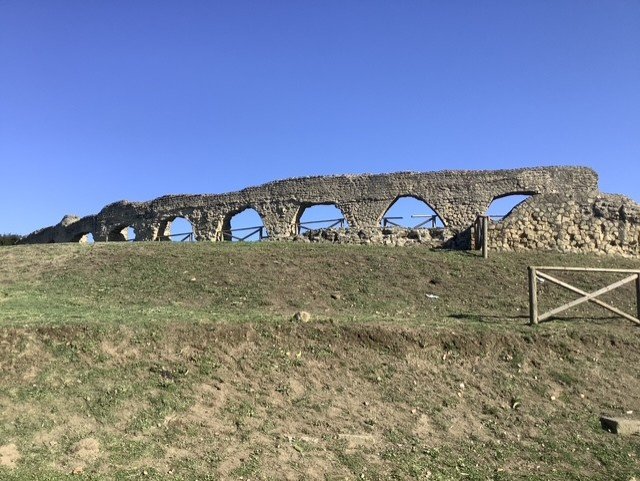XXXV Cuma (Cumae)
What3words – invited.psyching.lonely (Villa entrance retract.overslept.typhoid)
Construction - Ist Century BC
Capacity - 8,000
Visited January 2025
Status – Tranquil and pretty with commanding views of Ischia. The Amphitheatre lies within the private gardens of Villa Vergiliana, which is owned and run as a study centre for classics students by the Vergilian Society of America.
The westbound road from Pozzuoli (Via Arco Felice Vecchio) undergoes a uniquely Italian transformation just north of Lago di Averno (another extinct volcanic crater). The two lane tarmac suddenly narrows and for 100 metres or so the road surface reverts to that of ancient Rome. This passes through a cutting in a ridge. which is bridged by a high Roman Arch, through which only two very small cars (or chariots) can pass each other (Arco Felice Vecchio). At the next junction a right turn takes you past the settlement of Cuma (Cumae) and on to the Via Domitiana, the Roman super highway built to link the ports of Pozzuoli and Misenum with Rome. The left turn towards Misenum describes, after a short distance, a curve around the perimeter of the Cuma amphitheatre. The road is narrow and busy (even in January) and there is nowhere to stop other than in a recessed gateway where locked gates and high railings bar the way into the arena. There is no indication of visiting times or dates.
Just to the north, near the road junction, an opening on the right splits into two narrow roads. The one on the left is a rutted unmade track serving some residential properties, the one to the right is the driveway of a large crenellated house ‘Villa Vergiliana’ with commanding views across the bay towards the island of Ischia. Emboldened by the complete lack of people anywhere, I drove into the property (shuttered up for winter) and, pausing only to note the sign on the front stating it was ‘The Harry Wilkes Study Centre’, made my way past a couple of olive trees and fruit bushes and into the Cuma Amphitheatre, which forms the larger part of the garden of the villa. The amphitheatre has well-preserved stonework and a row of arches in the outer wall. The grassy banks of the cavea are planted with fruit bushes and several orange trees. It was deserted save for a couple of indifferent gardeners who showed no inclination to chase me off the premises.
The Amphitheatte of Cuma is one of the smaller examples but also, along with that of Pompeii, one of the oldest in Campania. It was built at the end of the second century B.C. when the Greek-Samnite city was being converted to a Roman urbs, and lies just outside the southern walls of the old city. There is a large excavated visitor site a short distance away to the north at the side of the Via Domitiana, containing remains of the city. The amphitheatre is of banked and excavated earth without basements or underground areas and is dug into the sloping hillside. There is evidence of expansion in the second century A.D. with the construction of improved access routes to the seating.





